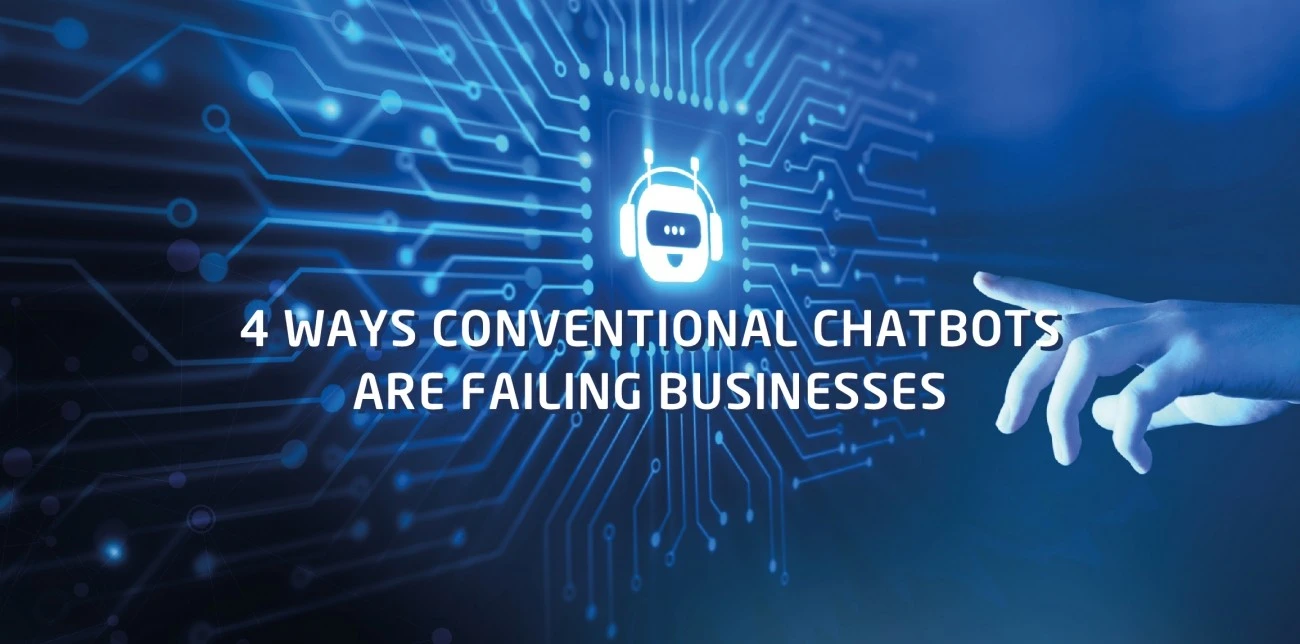
The introduction of chatbots enabled businesses to take their customer experience to the next level. Chatbots provide 24/7 support and ensure customers will get real-time responses. But with time, the cons of chatbots overshadowed its pros, failing businesses in many aspects.
The disadvantages of conventional or rule-based chatbots mainly relate to their predefined nature. So, how are conventional chatbots failing businesses?
They Don’t Understand Language Variations
Using slang, synonyms, and different dialects are unique characteristics of language that conventional chatbots fail to address.
Conventional chatbots depend on predefined conversational flow where certain words are identified as keywords. Chatbots will give answers they were programmed to provide when recognising these keywords.
If customers ask a question that the chatbot is programmed to answer using different phrasing the chatbot won’t provide the desired answer.
They also fail to remember the context, meaning that if the customer asks a follow-up question regarding an answer that’s been given, the rule-based chatbot will address it as a new question and fail to relate it to that answer.
In addition, conventional chatbots are known to be English-centric. English is the language of business, but for customers who are not native speakers, English-only chatbots will only rocket their frustration in critical situations.
This inability to fully understand language variations affects the accuracy of the conventional chatbots’ responses. The last thing an angry customer needs is to receive irrelevant answers. It’s an overall customer experience disaster.
Robotic Interaction
The main purpose chatbots are meant to serve is to take the load off customer service agents while maintaining the human touch. But conventional chatbots are not quite successful in offering human-like interactions.
Part of this problem lies in the language barrier we discussed and the fact that any deviation from their predetermined scope is deemed unanswerable.
The conventional chatbot experience is also not friendly or personalised. The robotic aspect is off-putting. Conventional chatbots respond in rigid language and don't imitate humans' conversational style.
Conventional chatbots can't understand that the customer's tone is changing, and they must be addressed more empathetically.
Too Expensive to Scale
Scalability is one of the rule-based chatbots’ disadvantages. Conventional chatbots are scalable, but it is too expensive and time-consuming to do so. They rely on programming which means they require constant maintenance and revisions to feed them the data needed to expand their knowledge base and capabilities to answer customers’ queries.
Conventional chatbots are unable to learn from unanswered questions and unique interactions to address similar situations in the future.
Updating a conventional chatbot entails an analysis of the bot's previous conversations to determine the most frequent questions they are asked and what data they need to answer them.
A Single-Channel Tool
Customers love to have options when communicating with a business, they want an omnichannel experience and conventional chatbots don’t offer that. They can only be deployed as a chat interface on a website, a social media platform, or an app.
So, how can businesses tackle these obstacles?
Conversational AI to the Rescue
Conventional chatbots are the foil character to conversational-AI chatbots. They simply play the human-like interaction game better. They understand dialects, slang and synonyms and don’t depend on scripted answers.
They respond using natural, engaging language that is more appealing to costumes, which eliminates the robotic feeling. They can also be multilingual.
Conversational AI chatbots excel on the scalability side as well. They can learn from previous interactions and expand their knowledge with no manual updates.
Businesses adopting conversational AI chatbots can offer their customers an omnichannel experience allowing them to communicate through their preferred channels. They can be used in chat interfaces, SMS, email messaging, social media messaging, and virtual agents.
EDC’s Conversational AI Platform
Realising conversational AI is the future of customer-centric industries, EDC offers businesses a cutting-edge multilingual conversational AI platform to meet customers wherever they are.
Equipped with the right tools, including the intent manager, conversational builder, conversational orchestrator, conversational manager, and conversational analytics, we guarantee businesses will enjoy an increase in customer satisfaction and a boost in revenue.
Tackle the barriers of conventional chatbots and request a demo to learn more about our conversational AI solution.



